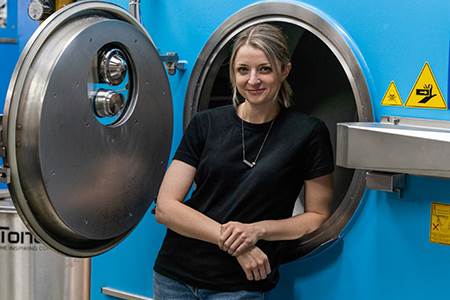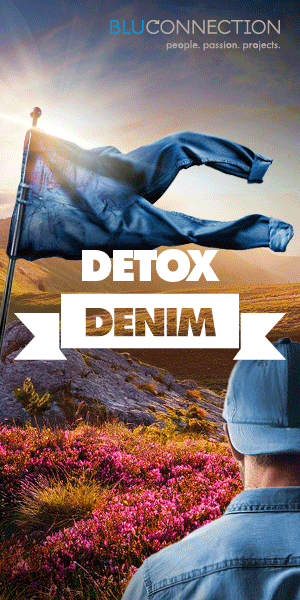Leanne Jae: developing a London wash aesthetic

The wash whizz and laundry manager behind a newly opened denim research and development lab at London jeansmaker Blackhorse Lane Ateliers (BLA), Leanne Jae, also an independent denim, development and wash consultant, discusses her passion for stretching the technologies and minds of both today and tomorrow.
What should a London or UK wash aesthetic look like?
The really exciting answer to this question is that we don’t know, but we are slowly learning and excited to rediscover it after we previously lost this much-loved industry in London.
The opening of BLA’s new wash research and development lab marks the first time small, independent UK start-ups and students will have access to Tonello laser and All-in-One machinery. Ordinarily, you would need high minimum order quantities for offshore facilities to gain access to similar technology, as it is a big investment. At BLA, we received a grant from University of the Arts London, which will enable us to connect with the city’s students and empower the next generation of talent earlier on, by providing them with knowledge they would otherwise only develop once working in the industry. We are looking forward to seeing how students interrogate and push the boundaries of the technology.
What excites you, especially given your design background, about today’s sustainable denim chemistries and technologies?
What excites me right now is that everyone is not only talking about advancements in our industry, but also taking real steps towards better chemicals or bio-based alternatives, in combination with new technologies. I was invited to visit Tonello last year by speciality chemicals group CHT, who wanted to share how their new organIQ finishing range could be used in harmony with the machinery I work with. The two worlds of chemistry and technology are talking to each other, and it makes me very excited to continue to observe progression in either field. For me, this means they are considering the outputs and effects that are achievable, thereby illuminating future possibilities or steppingstones to what could one day become commercially viable with further development. It also gives designers and product developers opportunity to play once again – every day, we are learning about what is achievable with O-Zone, for instance. THE Laser, meanwhile, opens up endless possibilities in terms of patterns and designs.
As a designer, it is like a reset button is pressed every time something new is launched and it is incredibly exciting to see what the minds of today and tomorrow discover with it.
Looking to the future, how will science inform artisanship and vice versa in a well-thought-out circular denim economy?
I see science being inspired by nature, looking at how ecosystems or organic matter have evolved and function. Recent moves towards biodegradable stretch fibres from natural rubber is a perfect example of how we can help ensure products compost at end of life. Some consider that a closed loop.
There is also a lot of focus right now on recycling and how we can best facilitate that process. You really must dissect every stitch and trim, alongside the fibre choice, to allow for complete recycling. Science can help improve the engineering of components and I hope specialists will only continue to come up with solutions, not only at garment level, but also from the very start of the value chain, such as paying closer attention to farming and how we can regenerate the land we take from.
Another way to answer this question is that we really must begin to make less and, when we do make new jeans, for instance, we need to make them so they can outlast us and be passed down over many generations. We need to relearn the make-do-and-mend mentality and stop with the throwaway culture that has sadly become normalised. The jeans at BLA are crafted in this way; they are designed with the best fabrics and made using traditional, highly durable construction techniques. Our commitment to repair jeans for life post-purchase further solidifies our mission to create jeans that will outlast their original buyer.
What is the most overlooked stage in eco-product development right now?
I don’t know if this is because I have just started researching it, or if it is indeed overlooked, but I am really interested in dyeing methods and application. Synthetic indigo is mostly what we all wear and while liquid over powder application is best, there have been some very incredible advancements towards replacing this widely used, yet highly criticised, dyestuff. How the warp is dyed is also crucial to sustainable laundry processing. When we select denims, we need to make sure the yarn is ready for the laser technology, so we can reduce energy consumption and ensure clarity on the laser file.
Regenerative cotton is also a hot topic – and deservedly so, as we have massively overlooked this area for too long. We need to focus on soil health and making sure we are looking after the farms and the earth we take from.
Another very important answer to this question, which I am very passionate about, as it is a simple solution: don’t overproduce! We make so much in development before a range is even selected for the consumer to buy that we all need to start taking accountability and reduce this. I have worked for too many companies that disregard this element, as they think it necessary to have a back-up for the back-up options. It’s crazy. Technology is helping us create visual mock-ups, but in denim I can see how this can be difficult, as it is a really technical fabric, and you also need to see how each wash affects the fit.
If you could visit anywhere – or anyone – in the world to further enrich your knowledge of denim laundering and finishing, where or who would that be and why?
I visit Tonello on a regular basis. They are always teaching and inspiring me; they are an extension of the BLA family. I think it is about learning as much as you can with the tools you have and for me that is the technology I have in the lab. My development is ongoing and always will be. I never stop learning and researching, as our industry shifts every day.
My passion is in driving our industry towards better education and this is key; it’s not just for students, we need to empower everyone that works with denim fabrics with knowledge about how they are processed and finished. It’s complex, but it is also accessible and possible to understand, without being too overwhelming. With knowledge, we can become better designers and I believe strongly that this can pollinate into other business areas, too. Personally, I have grown the most as a designer in the past few years, since I have become equipped with washing knowledge. I used to think I didn’t have the capacity to understand it, but knowledge is contagious, and I really do feel the benefit.
In the future, I would love to go back to Japan to learn from the laundries and mills there, to study their commitment and culture of true artisanship further. I think they also have the closest connection to natural indigo, and they showcase this perfectly through their love and passion for craft and small-scale production.
What makes you happiest in your work and what, for you, are the best indicators of a job well done?
If the customer is happy, I am happy. Every project is a challenge, as every fabric is unique, and it will behave differently as a result. I am always looking to refine and better what I do, and every recipe is an evolution of the previous one. Can I save more water, for example, or is it possible to use a different part of the technology, etc. I’m letting go of the idea of perfection, but resigning myself to the promise that I will do the best I can, with the knowledge and possibilities available to me. I think that’s all we can do as human beings and it should be a pledge that we all make in the industry: not to do something because it is trending, but because it is possible to be better.
How do you revitalise your creative eye and energies?
Great question. I feed off the knowledge of others and try to absorb as much as possible in everyday occurrences, never taking anything for granted or undervaluing its potential. I love working with students and I am so honoured to be a part of universities’ educational programmes. The open minds, untouched or shaped by industry dynamics, is the purest form of creative energy and I am so lucky to get access to that when I work with them.
Any tips for building confidence and trusting your own ideas in an ever-changing industry?
Always be open to learning something new every day. The industry, as you say in your question, is ever-changing, but if we all make a commitment to staying as up to date as we possibly can with the knowledge and resources available to us, we are going to be able to build confidence in our informed decisions and ideas. Never assume to know all there is, I certainly do not and am not sure I ever will, but I make a conscious effort to reach out to the people who do know, if I don’t, to be able to learn.
We are incredibly lucky in the denim sector. It is one of the most collaborative fields, made up of people who genuinely care about their industry and work together to find sustainable and better solutions.
Photo credit: Illya Sobtchak













